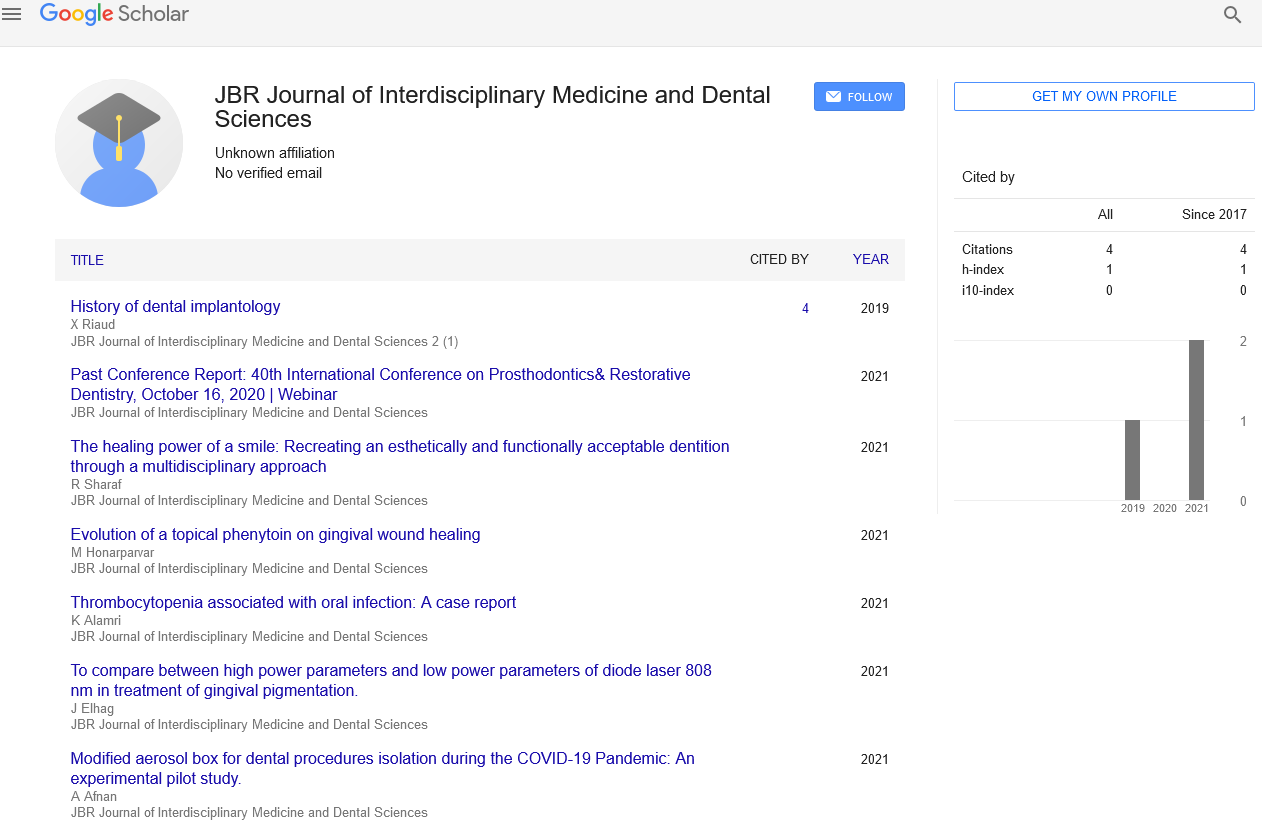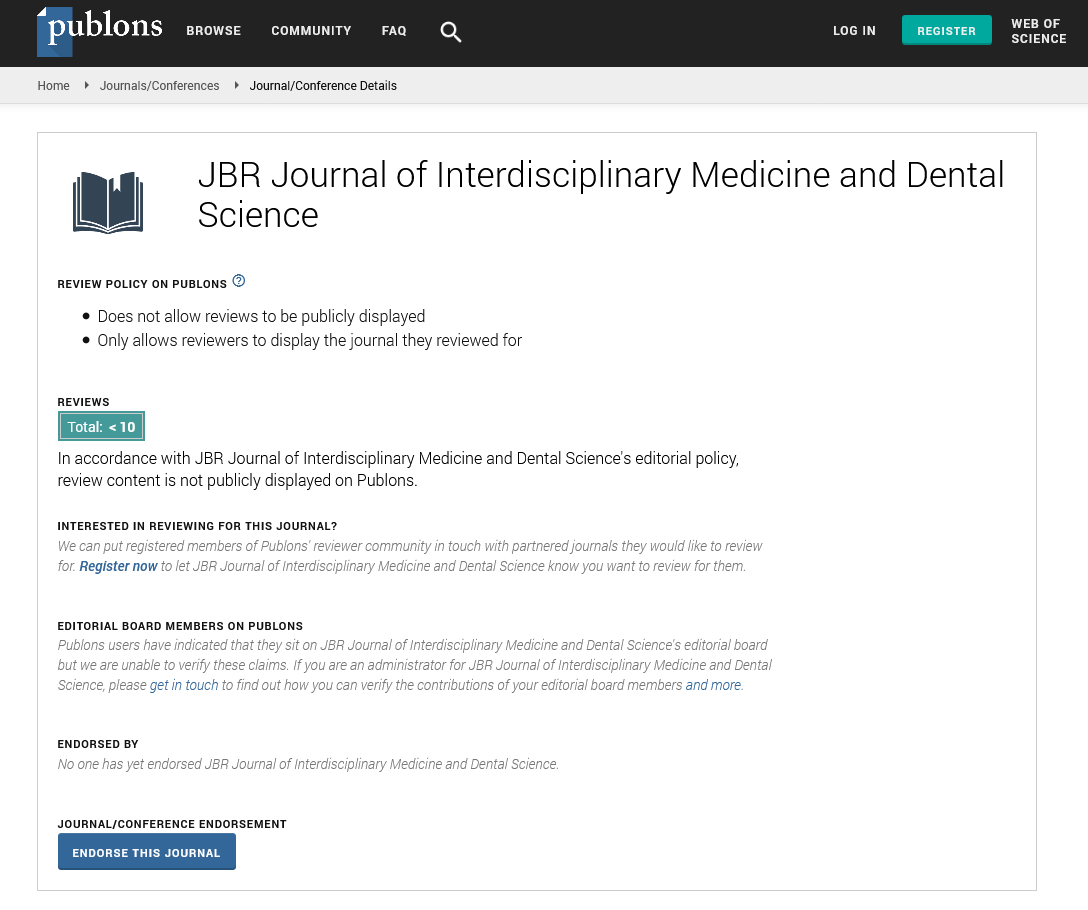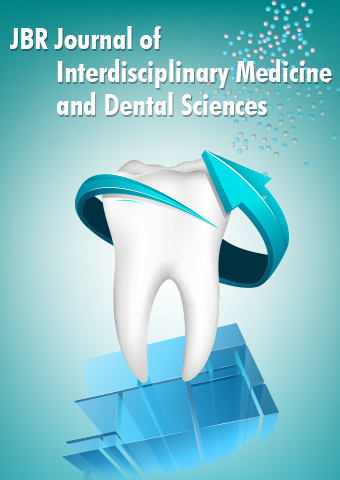Review Article - JBR Journal of Interdisciplinary Medicine and Dental Sciences (2023) Volume 6, Issue 4
Temporomandibular Disorders: Understanding, Diagnosis, and Management
Anderson Hook*
Department of Dental Science, Australia
Department of Dental Science, Australia
E-mail: hook_anderson19@gmail.com
Received: 1-July-2023, Manuscript No. jimds-23-108285; Editor assigned: 4-July-2023, PreQC No. jimds-23-108285 (PQ); Reviewed: 19-July-2023, QC No. jimds-23-108285; Revised: 24-July-2023, Manuscript No. jimds-23-108285 (R); Published: 31-July-2023, DOI: 10.37532/2376- 032X.2023.6(4).82-84
Abstract
Temporomandibular Disorders (TMDs) constitute a diverse group of conditions affecting the temporomandibular joint (TMJ) and adjacent structures, presenting with a myriad of symptoms that can vary in severity. This article provides a comprehensive overview of TMD, including its etiology, clinical presentation, diagnostic methods, and various treatment modalities. TMDs arise from a complex interplay of biological, environmental, and psychological factors, with common risk factors such as malocclusion, bruxism, trauma, stress, arthritis, and connective tissue disorders. Clinical presentations often include jaw pain, restricted jaw movement, clicking or popping sounds, headaches, ear pain, and facial muscle tenderness. The accurate diagnosis of TMDs involves a thorough examination, encompassing medical and dental history, clinical assessment, imaging studies, and bite analysis. The management of TMDs aims to alleviate pain, improve jaw function, and enhance overall oral health. Treatment options encompass self-care practices, medications, occlusal splints, physical therapy, behavioral therapy, dental procedures, and injections. A multidisciplinary approach involving dental and medical professionals is crucial for effectively addressing TMDs and improving the quality of life for affected individuals. By understanding the complexities of TMDs and employing appropriate diagnostic and therapeutic strategies, healthcare providers can optimize patient outcomes and provide comprehensive care for those experiencing TMD-related challenges.
Keywords
Temporomandibular disorders • TMJ • Etiology • Risk factors • Clinical presentation
Introduction
Temporomandibular Disorders (TMD) constitute a diverse and complex group of conditions that affect the temporomandibular joint (TMJ) and its associated structures [1]. The TMJ plays a crucial role in facilitating essential functions, such as chewing, speaking, and swallowing, making any disruption to its proper functioning a matter of significant concern. TMDs are known to cause a wide range of symptoms, including jaw pain, restricted jaw movement, clicking or popping sounds, headaches, and facial muscle tenderness, among others. Understanding TMD is paramount, as these disorders can have far-reaching implications for both oral health and overall well-being [2]. As TMDs arise from multifactorial origins, it is crucial to explore the interplay of biological, environmental, and psychological factors that contribute to their development. Identifying the risk factors associated with TMD can provide essential insights for both prevention and targeted treatment approaches. Accurate diagnosis is fundamental for effective management of TMDs, yet it remains a challenging aspect of clinical practice [3]. The diverse range of symptoms and potential overlap with other conditions necessitate a comprehensive evaluation, combining medical and dental history, clinical examination, imaging studies, and bite analysis. Advancements in diagnostic techniques have enabled healthcare professionals to gain better insights into the underlying causes of TMD, facilitating more personalized and tailored treatment strategies [4]. This article aims to provide a comprehensive overview of Temporomandibular Disorders, delving into their etiology, clinical presentation, diagnostic methods, and various treatment modalities.
By synthesizing current knowledge and research, we aim to equip healthcare providers with a better understanding of TMDs, allowing for improved patient care and enhanced overall quality of life for individuals experiencing these disorders [5]. Moreover, a multidisciplinary approach, involving both dental and medical expertise, is crucial in tackling the complexities of TMDs and devising holistic treatment plans [6]. Together, we endeavor to shed light on the intricacies of TMDs, driving further research and advancements in this vital field of dental and medical sciences.
Material and Methods
Temporomandibular Disorders (TMD) encompass a range of conditions affecting the temporomandibular joint (TMJ) and surrounding structures [7]. These disorders have significant implications for oral health, quality of life, and overall well-being. TMDs are complex and multifactorial, making diagnosis and management challenging for dental and medical professionals [8]. This article aims to provide a comprehensive overview of TMD, including its etiology, clinical presentation, diagnostic methods, and various treatment modalities.
I. Etiology and risk factors
TMDs arise from a combination of biological, environmental, and psychological factors. Some common risk factors include:
Malocclusion: Dental malalignment can place excessive stress on the TMJ.
Bruxism: Teeth grinding and clenching can lead to TMJ dysfunction.
Trauma: Physical injury to the jaw can cause TMD symptoms.
Stress and Anxiety: Emotional factors may exacerbate TMD symptoms.
Arthritis: Inflammatory joint conditions can affect the TMJ [9].
Connective tissue disorders: Conditions like Ehlers-Danlos syndrome may contribute to TMD.
II. Clinical presentation
TMDs often manifest with a variety of signs and symptoms, which can vary from mild to severe. Common clinical presentations include:
Jaw pain: Pain in and around the jaw joint is a hallmark symptom.
Restricted jaw movement: Patients may experience difficulty opening or closing their mouths.
Clicking or popping sounds: Audible joint noises during jaw movement.
Headaches: Recurrent headaches, often radiating from the jaw to the temples.
Ear Pain and Fullness: Discomfort in the ears due to the proximity of the TMJ.
Facial muscle tenderness: Muscles around the jaw may become tender and painful.
III. Diagnosis: Accurate diagnosis is crucial for effective management of TMDs. Diagnosis involves a comprehensive evaluation, including:
Medical and dental history: Assessing the patient’s health background and previous oral treatments.
Clinical examination: Physical examination of the jaw, face, and neck to identify abnormalities. Imaging studies: X-rays, CT scans, or MRI to visualize the TMJ and surrounding structures.
Bite analysis: Studying the occlusion to identify any malocclusion-related issues.
IV. Treatment modalities
Treatment of TMDs aims to relieve pain, improve jaw function, and enhance overall oral health. Several management options are available, including:
Self-Care: Encouraging stress reduction techniques, jaw exercises, and avoiding harmful habits like teeth grinding.
Medications: Pain relievers, muscle relaxants, and anti-inflammatory drugs may be prescribed to alleviate symptoms.
Occlusal splints: Custom-made oral appliances to reposition the jaw and reduce clenching and grinding.
Physical therapy: Jaw exercises and manual therapy to improve jaw function and reduce pain.
Behavioral therapy: Cognitive-behavioral techniques to manage stress-related triggers.
Dental Procedures: Orthodontic treatment to correct malocclusion or dental restorations to improve occlusion. In some cases, corticosteroid or botulinum toxin injections may be used for pain relief [10].
Discussion
Temporomandibular Disorders can significantly impact a patient’s quality of life, affecting daily activities such as eating, speaking, and even sleeping. A comprehensive approach to diagnosis and management involving dental and medical professionals is essential to effectively address TMDs. By understanding the etiology, recognizing the clinical presentation, and employing appropriate treatment modalities, healthcare providers can provide relief and improve the overall well-being of individuals suffering from TMDs. These disorders have significant implications for oral health, quality of life, and overall well-being. TMDs are complex and multifactorial, making diagnosis and management challenging for dental and medical professionals. This article aims to provide a comprehensive overview of TMD, including its etiology, clinical presentation, diagnostic methods, and various treatment modalities.
Conclusion
Temporomandibular Disorders (TMDs) present a multifaceted challenge to the field of dental and medical sciences, impacting the lives of countless individuals worldwide. The diversity of symptoms and complex etiology make TMDs a unique area of study, demanding a holistic and multidisciplinary approach to their understanding and management. Through this comprehensive exploration of TMDs, we have gained valuable insights into the factors contributing to their development and the various treatment modalities available for affected individuals. The intricate interplay of biological, environmental, and psychological factors underscores the need for a broader perspective when addressing TMDs. Healthcare professionals must collaborate to accurately diagnose and effectively manage TMDs, with each case requiring personalized and tailored approaches to suit the individual’s needs. The advancements in diagnostic techniques and treatment options offer hope for individuals suffering from TMDs. From self-care practices and physical therapies to dental procedures and pharmacological interventions, the spectrum of available treatments provides patients with a range of choices to alleviate symptoms and improve their quality of life. As we continue to advance in our understanding of TMDs, ongoing research and collaboration between dental and medical professionals remain paramount. A deeper comprehension of TMDs’ underlying mechanisms will pave the way for more innovative and targeted therapeutic interventions, leading to improved patient outcomes. In conclusion, this article emphasizes the significance of Temporomandibular Disorders as a challenging and diverse field within the realm of dental and medical sciences. By recognizing the complexities of TMDs and fostering a multidisciplinary approach, we can enhance patient care and strive toward alleviating the burden of TMDs on individuals and communities alike. With a commitment to further research and clinical practice, we aspire to provide comprehensive support and relief for those affected by TMDs, fostering optimal oral health and overall well-being for all.
References
- Tonesk X, Buchanan RG. An AAMC pilot study by 10 medical schools of clinical evaluation of students. J Med Educ. 62, 707–718 (1998).
- Mays N, Pope C. Qualitative research in health care. Assessing quality in qualitative research. BMJ. 320, 50–52 (2000).
- Kassebaum DG, Eaglen RH. Shortcomings in the evaluation of students’ clinical skills and behaviors in medical school. Acad Med. 74, 842–849 (1999).
- Siminoff LA, Zhang A, Colabianchi N et al. Factors that predict the referral of breast cancer patients onto clinical trials by their surgeons and medical oncologists. J Clin Oncol. 18, 1203– 1211 (2000).
- Ross S, Grant A, Counsell C et al. Prescott RJ. Barriers to participation in randomised controlled trials. J Clin Epidemiol. 52, 1143– 1156 (1999).
- Ding EL, Song Y, Malik VS et al. Sex differences of endogenous sex hormones and risk of type 2 diabetes. Jama. 295,1288-1299 (2006).
- Mohammed M, Al-Habori M, Abdullateef A et al. Impact of metabolic syndrome factors on testosterone and SHBG in type 2 diabetes mellitus and metabolic syndrome. J Diabetes Res. 492, 78-98 (2018).
- Malipatil NS, Yadegarfar G, Lunt M et al. 14-year prospective outcome in 550 men with type 2 diabetes. Endocrinol Metab. 2, 3-4 (2019).
- Kelsey MM, Bjornstad P, McFann K et al. Testosterone concentration and insulin sensitivity in young men with type 1 and type 2 diabetes. Pediatr Diabetes. 17,184-190 (2016).
- Juneja R, Palmer JP. Type 1 1/2 diabetes: myth or reality? J Autoimmun. 29, 65-83 (2009).
Indexed at, Google Scholar, Crossref
Indexed at, Google Scholar, Crossref
Indexed at, Google Scholar, Crossref
Indexed at, Google Scholar, Crossref
Indexed at, Google Scholar, Crossref
Indexed at, Google Scholar, Crossref
Indexed at, Google Scholar, Crossref
Indexed at, Google Scholar, Crossref
Indexed at, Google Scholar, Crossref


